DCC Awareness Day 2025: WE ARE… A Family!
.
By Miriam Bernard
Every year on July 2nd, the NODCC joins family organizations around the world to celebrate DCC Awareness Day: a day as symbolic as it is significant. Situated at the exact midpoint of the calendar year, it mirrors how the corpus callosum serves as that vital bridge between the left and right hemispheres of the brain. Our mission through DCC Awareness Day is clear: light the torch of awareness, nurture understanding, and spark action. By sharing our stories, statistics, and experiences, we humanize this invisible brain condition. Awareness is the first step toward compassion, and from there, we channel efforts into research, resources, and community.
Just a few weeks before last year’s DCC Awareness Day, the NODCC held its 2024 international conference in Chicago, welcoming nearly 500 registered participants, nearly two-thirds of whom were new to our gathering. Over four days, the halls hummed with 60 sessions devoted to medical insights, genetic research, behavior strategies, and educational approaches. Our Adults with DCC program had inspiring moments as individuals shared their firsthand perspectives, joys, hurdles, and resilience. Through seminars led by top-tier researchers such as Drs. Elliott Sherr, Lynn Paul, Warren Brown, and Linda Richards, families left armed with new knowledge and deeper solidarity.

.
.
.
.
.
.
.
.
..
One iconic moment came when attendees gathered to sign a large white banner emblazoned with the words “We are …”. One by one, individuals and families inscribed adjectives that speak volumes:
- “We are determined” Demonstrating that we’re standing firm in advocacy and hope.
- “We are resilient” Emphasizing how individuals with DCCs navigate challenges with courage.
- “We are united” Highlighting the incredible bond between families, professionals, and loved ones.
- “We are proud” Celebrating identity, love, and belonging.
- “We are hopeful” Looking toward the future with optimism for discovery and acceptance.
- “We are compassionate” Reminding the world to lead with empathy.
These shared affirmations formed a beautiful tapestry, capturing not only personal identity of our community members, but also our collective purpose.
The significance of that banner carries into DCC Awareness Day itself. We urge all supporters to use their torches, literal or symbolic, to illuminate bridges in their own communities: share photos from bridges, post research facts, upload stories, and host fundraisers! By sparking conversations, we ensure that DCC is not just known, but understood, accepted, and supported.
As the NODCC moves toward future conferences, virtual gatherings, and grassroots events, our commitment remains unwavering. Whether in July and August’s regional meetings or through monthly support forums for parents, adults, and siblings, our global family continues to grow and strengthen. On this DCC Awareness Day (and every day!) we celebrate how far we’ve come, and we renew our dedication to where we’re going: toward greater awareness, deeper understanding, and actions that build brighter futures for all with DCCs.
Join us on July 2nd. Take up your torch! Declare “We are …” and shine a light that inspires the world. We can’t wait to see your posts, read your messages, and see the ways you share who WE ARE with the world. Please tag the NODCC as you raise your voice on July 2nd, as we would love to feature stories and posts from our amazing community. Thank you for helping us spread awareness and empower those living with DCCs!
.
How can you bring awareness?
- Take a photo or video on a bridge and share it on your social media pages and on the NODCC social posts. You can also change your profile picture on Facebook to the image. In your photo on a bridge, you can hold up a photo of your loved one with a DCC (or have them with you), hold up the DCC Awareness Day logo or any of the 7 images below, or any other creative idea you can think of!
- Like, comment on, and share our posts on Facebook (facebook.com/NODCC/) and Instagram (instagram.com/livingwithdcc)
- Add a DCC frame to your Facebook profile pic using the Canva template linked HERE.
- Educate your community: Disorders of the corpus callosum are not as rare as we thought when the NODCC was established. Recent data analysis shows a frequency of diagnosis for DCC (in individuals under the age of one year) to be 1 in every 2,053 individuals. Help bring these statistics to light by sharing them with those in your circle!
- Wear your favorite NODCC merch! Click here to stock up: https://www.bonfire.com/store/nodcc/
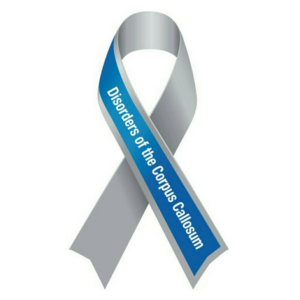
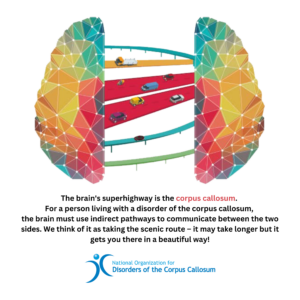

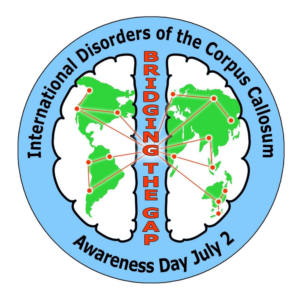
.
.
……………………………………………………………………………………………………………………………………………………………………………………………………………………………………………………………………………………………………………………………………………………………………………………………………
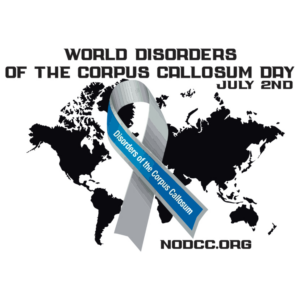
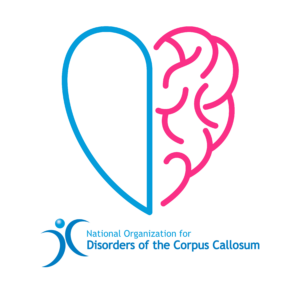
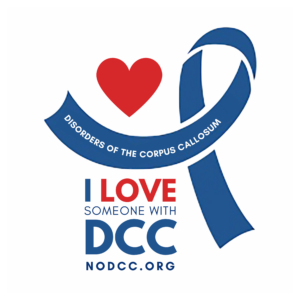
……………………………………………………………………………………………………………………………………………………………………………………………………………………………………………………………………………………………………………………………………….
How can you help foster understanding?
- Share your DCC story on social channels.
- Create a short 1-2-minute video introducing others to living with a DCC.
- Share your story or ideas with local parenting magazines, newspapers, and websites (you can find the editorial contact within the magazine or online)
- Living with a disorder that most people haven’t heard of
- Invisible disabilities
- Celebrating holidays with special needs kids
- Special needs summer fun
How can you be a catalyst for action?
- Ask your local library to host summer story time with a reading of ACC and Me
- Direct people to our DCC Awareness Day page: nodcc.org/dcc-awareness-day/
- Start a Facebook fundraiser on July 2 to raise awareness
- Host a fundraiser and awareness day at a local restaurant.
- Host a lemonade stand or other homemade fundraiser.
.
.
.
.
Tough body: the corpus callosum
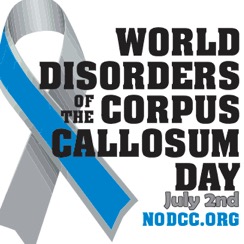
Imagine being told your child is missing something that you didn’t even know existed. This is what many families experience when they first learn that their child is missing the largest and most important pathway (of nerve fibers) in the brain. Latin for “tough body,” the corpus callosum is the main connector that allows for direct communication between the left and right halves (hemispheres) of the brain.
As we coordinate movements or think about complex information, the hemispheres of our brain are communicating with each other. In humans, each hemisphere specializes in doing specific skills and tasks. For most people, the left hemisphere plays a larger role in processing language and logic tasks of math and reasoning and the right hemisphere is more involved in creative tasks and emotions. The hemispheres make the best use of their expertise by working together to generate the activities, thoughts, and emotions we experience every day.
How do the halves communicate and work together? They use the corpus callosum! The corpus callosum is like a superhighway for moving information between the two sides of the brain — without it, information gets stuck in one hemisphere or the brain must use another pathway to send information to the other side. That is what happens in a disorder of the corpus callosum – the superhighway isn’t working so the brain has to use ‘side streets’ to get information from side to side.
Understanding the disorders
Disorders of the corpus callosum are not illnesses or diseases. They are abnormalities of brain structure and can only be diagnosed by a brain scan (such as a MRI, CT, or ultrasound). When the corpus callosum does not develop in a child (agenesis) or develops abnormally (dysgenesis), it cannot be repaired or replaced – but doctors are researching ways to improve the lives of those affected by the disorders. Current research suggests that as many as one person in 4,000 is born with agenesis or dysgenesis of the corpus callosum.
Some people with these conditions require medical intervention due to seizures or other medical conditions, but many others do not require medical treatment. However, many children with a corpus callosum disorder will need treatment to help overcome or cope with developmental delays, and others will need assistance into adulthood to help with difficulties in social and/or behavioral functioning.
For more information on the characteristics of individuals with the disorders, click here.
Individuals with disorders of the corpus callosum may face a variety of challenges that cover a broad range of disability. Since it is a brain disorder, the disabilities are not always visible to the eye. A child with a disorder of the corpus callosum may look typical, but socially or developmentally be far behind their actual age. Educating people about these diagnoses can help them become more accepting and compassionate about these invisible disabilities and can support families as they help their children navigate successfully through life. This is why we need awareness campaigns.
Studying the brain’s wiring
The brain is considered to be the most complex organ – actually, the most complex thing in the universe. Imagine being a researcher studying something so complex!
Since the effects of a disorder of the corpus callosum cannot be reversed or cured, researchers are working to understand how brain functioning changes when the connection is missing or altered. Ultimately, the goal of research is to develop effective interventions and strategies that will help people with these disorders function independently and have meaningful roles in society.
The National Organization for Disorders of the Corpus Callosum (NODCC) is the leading nonprofit organization dedicated to educating, enhancing lives and promoting understanding of these disorders. There have been significant strides in understanding and making life productive for those living with and caring for an individual with a disorder of the corpus callosum, but we need much more research to uncover more treatment and strategy options for improving lives and uncovering causes of the conditions.
Let’s make the corpus callosum a household name
“If you don’t know what the corpus callosum is, then it’s probably because you have one!”
World DCC Awareness Day reminds us to educate others about the corpus callosum and its important role in the daily functioning of our brains, as well as about the challenges faced by people who do not have a fully functioning corpus callosum. Understanding encourages compassion and helpfulness for people dealing with these disorders. It also helps shine a light on the need for more research and funding to benefit many individuals and families.
On this day, we recognize the many people whose lives are affected and challenged by disorders of the corpus callosum. We invite people to share stories, images and videos to be part of starting the conversation on disorders that many people do not understand. It’s a great day to spread awareness about the important role the corpus callosum plays within our brains, as well as the challenges people face if they do not have a fully functioning corpus callosum (or maybe don’t have one at all).
DCC Awareness Day was established in 2015 by the NODCC, AusDoCC and Corpal.

